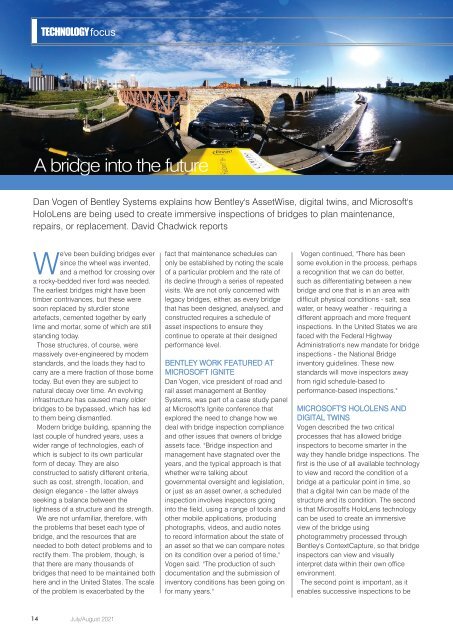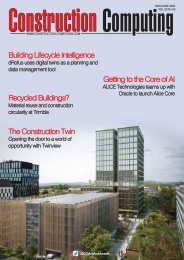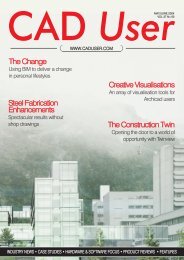Create successful ePaper yourself
Turn your PDF publications into a flip-book with our unique Google optimized e-Paper software.
TECHNOLOGY focus<br />
A bridge into the future<br />
Dan Vogen of Bentley Systems explains how Bentley's AssetWise, digital twins, and Microsoft's<br />
HoloLens are being used to create immersive inspections of bridges to plan maintenance,<br />
repairs, or replacement. David Chadwick reports<br />
We've been building bridges ever<br />
since the wheel was invented,<br />
and a method for crossing over<br />
a rocky-bedded river ford was needed.<br />
The earliest bridges might have been<br />
timber contrivances, but these were<br />
soon replaced by sturdier stone<br />
artefacts, cemented together by early<br />
lime and mortar, some of which are still<br />
standing today.<br />
Those structures, of course, were<br />
massively over-engineered by modern<br />
standards, and the loads they had to<br />
carry are a mere fraction of those borne<br />
today. But even they are subject to<br />
natural decay over time. An evolving<br />
infrastructure has caused many older<br />
bridges to be bypassed, which has led<br />
to them being dismantled.<br />
Modern bridge building, spanning the<br />
last couple of hundred years, uses a<br />
wider range of technologies, each of<br />
which is subject to its own particular<br />
form of decay. They are also<br />
constructed to satisfy different criteria,<br />
such as cost, strength, location, and<br />
design elegance - the latter always<br />
seeking a balance between the<br />
lightness of a structure and its strength.<br />
We are not unfamiliar, therefore, with<br />
the problems that beset each type of<br />
bridge, and the resources that are<br />
needed to both detect problems and to<br />
rectify them. The problem, though, is<br />
that there are many thousands of<br />
bridges that need to be maintained both<br />
here and in the United States. The scale<br />
of the problem is exacerbated by the<br />
fact that maintenance schedules can<br />
only be established by noting the scale<br />
of a particular problem and the rate of<br />
its decline through a series of repeated<br />
visits. We are not only concerned with<br />
legacy bridges, either, as every bridge<br />
that has been designed, analysed, and<br />
constructed requires a schedule of<br />
asset inspections to ensure they<br />
continue to operate at their designed<br />
performance level.<br />
BENTLEY WORK FEATURED AT<br />
MICROSOFT IGNITE<br />
Dan Vogen, vice president of road and<br />
rail asset management at Bentley<br />
Systems, was part of a case study panel<br />
at Microsoft's Ignite conference that<br />
explored the need to change how we<br />
deal with bridge inspection compliance<br />
and other issues that owners of bridge<br />
assets face. "Bridge inspection and<br />
management have stagnated over the<br />
years, and the typical approach is that<br />
whether we're talking about<br />
governmental oversight and legislation,<br />
or just as an asset owner, a scheduled<br />
inspection involves inspectors going<br />
into the field, using a range of tools and<br />
other mobile applications, producing<br />
photographs, videos, and audio notes<br />
to record information about the state of<br />
an asset so that we can compare notes<br />
on its condition over a period of time,"<br />
Vogen said. "The production of such<br />
documentation and the submission of<br />
inventory conditions has been going on<br />
for many years."<br />
Vogen continued, "There has been<br />
some evolution in the process, perhaps<br />
a recognition that we can do better,<br />
such as differentiating between a new<br />
bridge and one that is in an area with<br />
difficult physical conditions - salt, sea<br />
water, or heavy weather - requiring a<br />
different approach and more frequent<br />
inspections. In the United States we are<br />
faced with the Federal Highway<br />
Administration's new mandate for bridge<br />
inspections - the National Bridge<br />
inventory guidelines. These new<br />
standards will move inspectors away<br />
from rigid schedule-based to<br />
performance-based inspections."<br />
MICROSOFT'S HOLOLENS AND<br />
DIGITAL TWINS<br />
Vogen described the two critical<br />
processes that has allowed bridge<br />
inspectors to become smarter in the<br />
way they handle bridge inspections. The<br />
first is the use of all available technology<br />
to view and record the condition of a<br />
bridge at a particular point in time, so<br />
that a digital twin can be made of the<br />
structure and its condition. The second<br />
is that Microsoft's HoloLens technology<br />
can be used to create an immersive<br />
view of the bridge using<br />
photogrammetry processed through<br />
Bentley's ContextCapture, so that bridge<br />
inspectors can view and visually<br />
interpret data within their own office<br />
environment.<br />
The second point is important, as it<br />
enables successive inspections to be<br />
14<br />
<strong>Jul</strong>y/<strong>Aug</strong>ust <strong>2021</strong>

















